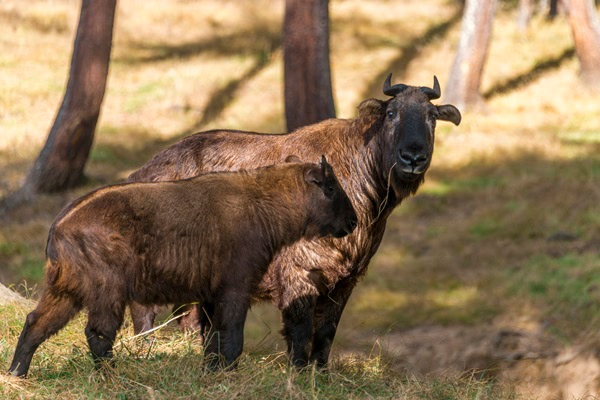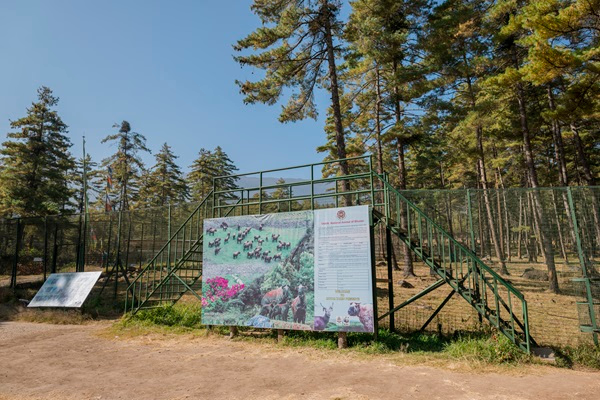
The Takin, the national animal of Bhutan, is a fascinating creature that embodies the country's unique blend of natural beauty and rich cultural heritage. Known for its distinctive appearance, the Takin has captivated locals and visitors with its mythical origins and ecological significance.
As Bhutan's national animal, the Takin holds a special place in the hearts of the Bhutanese people, symbolizing their deep connection to nature and spiritual traditions.
In this blog, we delve into the intriguing world of the Takin, exploring its physical characteristics, habitat, cultural significance, and the conservation efforts dedicated to preserving this remarkable species.
1. They Secrete An Oil That Makes Their Fur Repel Water
The Takin, Bhutan's national animal, is a unique and sturdy mammal distinguished by its thick neck, deep chest, and short, muscular legs. Its broad head features large, curved horns, which can grow up to 12 inches in males.
The Takin's shaggy coat, ranging from yellowish-brown to golden, provides insulation against the cold and helps it blend into its forested and rocky habitats. This coat is also covered in a strong-smelling, oily secretion that repels water and marks territory.

Physically, Takins stand between 97 and 140 centimeters at the shoulder and have a body length of 160 to 220 centimeters. Males typically weigh between 300 and 350 kilograms, while females are slightly lighter.
These animals are well-adapted to their high-altitude environments. Their broad hooves and powerful build aid in navigating steep, rugged terrains.
2. They Thrive In Bhutan's High Mountainous Regions
The Takin inhabits the rugged, high-altitude regions of the eastern Himalayas, primarily in Bhutan but also in parts of India, China, and Tibet.
In Bhutan, they are predominantly found in temperate and subalpine forests and rocky, grass-covered alpine zones at elevations between 1,000 and 4,500 meters. These environments provide the necessary cover and food sources, such as bamboo shoots, leaves, and grasses, which form the core of their diet.
The distribution of the Takin in Bhutan includes the country's northwestern and far northeastern regions. They are particularly well-known in the Motithang Takin Preserve in Thimphu, which was established to protect these animals.
This preserve allows visitors to observe Takins in a semi-natural habitat, fostering conservation and educational opportunities.
3. Takins Are Revered In Bhutanese Culture And Religion
The Takin holds a special place in Bhutanese culture and mythology. According to legend, the revered Tibetan saint Lam Drukpa Kunley, known as the Divine Madman, created the Takin through a miraculous act. He reportedly assembled the animal from the head of a goat and a cow's body, bringing it to life with a snap of his fingers.
This mythological origin story contributes to the Takin's high religious significance and status as Bhutan's national animal. The Takin symbolizes Bhutan's rich cultural heritage, intertwining spiritual beliefs with the country's natural landscape.
4. They Are Herbivores With Unique Grazing Habits
The Takin is a social animal, typically found in small family groups of around 20 individuals. However, larger herds can form in summer when they gather in areas with abundant food sources. These animals are diurnal, most active in the early morning and late afternoon.
Their diet mainly consists of leaves, grasses, bamboo shoots, and flowers. Takins are known to stand on their hind legs to reach high foliage. Takins also frequent salt licks, which are crucial for their mineral intake.
When threatened, they emit a distinctive 'cough' alarm call and use dense bamboo thickets for camouflage. This behavior and their diet underscore their adaptation to the mountainous and forested regions they inhabit.

5. Takins Are A Vulnerable Species Due To Habitat Loss
The Takin is listed as Vulnerable on the IUCN Red List due to threats such as habitat loss, hunting, and illegal wildlife trade. Their natural habitats are increasingly fragmented, reducing the space available for these animals to roam and find food.
Hunting for their meat and horns has further exacerbated their decline. The Bhutanese government has implemented various conservation measures, including establishing protected areas and wildlife corridors.
The Motithang Takin Preserve in Thimphu is a notable example. It serves both as a sanctuary for the Takin and an educational site for visitors to learn about these unique animals.
6. You Can Spot Takins In Bhutan's Wildlife Sanctuaries
Visitors to Bhutan can observe the Takin in the Motithang Takin Preserve, located in the capital city of Thimphu. Originally a mini-zoo, this preserve was transformed into a natural habitat to promote the well-being of these animals and align with Bhutan's values of compassion and conservation.
The preserve offers a unique opportunity to see Takins up close in a setting that mimics their natural environment, making it a popular destination for tourists and locals.
Additionally, Takins can sometimes be spotted in the wild within Bhutan's temperate and subalpine forests, particularly in the northwestern and northeastern regions of the country.
Conclusion About The National Animal Of Bhutan
The Takin, Bhutan's national animal, is a captivating symbol of the country's unique blend of natural beauty and cultural heritage. Protecting the Takin through various conservation efforts highlights Bhutan's commitment to preserving its wildlife and cultural symbols.
For those eager to witness the Takin up close, DrukAsia, the top Bhutan tour agency, offers cultural tour packages, including a visit to the Motithang Takin Preserve in Thimphu. This preserve provides a rare opportunity to see these majestic animals in a setting that resembles their natural habitat.
Book your tour with DrukAsia today and experience the magic of the Takin firsthand!
Frequently Asked Questions About The National Animal Of Bhutan
Where Can I See The Bhutan Takin In Its Natural Habitat?
The Bhutan Takin can be seen in its natural habitat at the Motithang Takin Preserve in Thimphu and in Jigme Dorji National Park, which provides a suitable environment for these animals.
Why Is The Takin Considered A National Symbol Of Bhutan?
The Takin is considered a national symbol of Bhutan due to its unique appearance and cultural significance. According to legend, it was created by the Divine Madman, Lam Drukpa Kunley, highlighting its importance in Bhutanese mythology and religious history.
What Are Some Other National Symbols Of Bhutan?
Other national symbols of Bhutan include the Raven (national bird), the Himalayan Blue Poppy (national flower), the Himalayan Cypress (national tree), the Thunder Dragon (national emblem), and the national flag. The national anthem reflects the country's rich heritage and values. Find out more about other mythical creatures in Bhutan.
How Does The Bhutan Takin Relate To The Country's Chief Guardian Deities?
The Bhutan Takin is deeply intertwined with Bhutan's spiritual traditions. It is believed to have been created by the Divine Madman, a revered saint. This connection enhances its significance as a national symbol representing the country's chief guardian deities.
What Is Jigme Dorji National Park's Role in Conserving The Bhutan Takin?
Jigme Dorji National Park is crucial in conserving the Bhutan Takin by providing a protected habitat that supports its population. The park's diverse ecosystem ensures the Takin and other wildlife thrive naturally.
